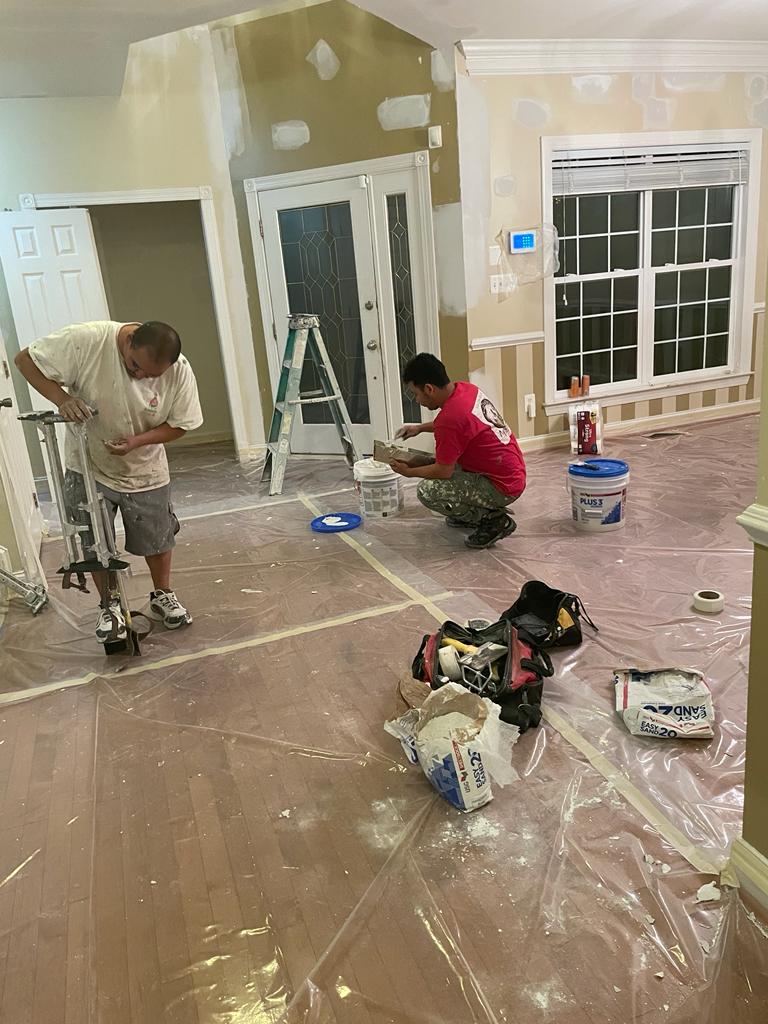What causes paint to blister? When you invest time and money into painting your home, the last thing you want is to see your hard work marred by unsightly paint blisters. These annoying bubbles can appear suddenly, turning a smooth finish into a rough, unattractive mess.
Many homeowners in Leesburg, VA, face this issue and wonder what causes paint to blister and how they can prevent it. This blog will explore the common causes of paint blistering, offering practical solutions to keep your paint job looking pristine. From poor surface preparation to moisture problems, understanding these factors is key to achieving a flawless finish.
Key Takeaways:
- Understand the common causes of paint blistering, such as poor surface preparation, moisture issues, high heat and humidity, low-quality paint, and applying paint too thickly.
- Learn preventive measures to avoid paint blisters, including proper surface preparation, addressing moisture problems, choosing suitable weather conditions, using high-quality paint, and applying paint in thin, even coats.
- Ensure a flawless, durable finish by following expert tips and best practices tailored to the unique climate conditions.
Understanding What Causes Paint to Blister
Paint blisters can be frustrating, but understanding their causes is the first step to preventing them. Here are some common reasons why paint may blister, helping you identify and address these issues effectively.
Poor Surface Preparation
One of the primary causes of paint blistering is inadequate surface preparation. When a surface isn’t properly cleaned or primed, the paint may not adhere correctly, leading to blistering. Dirt, grease, and old paint layers can prevent the new paint from bonding effectively, causing it to lift and form bubbles.
Moisture Issues
Another major cause of paint blistering is moisture. When moisture gets trapped beneath the paint surface, it can cause the paint to separate from the underlying material, forming bubbles. This issue is particularly common in areas with high humidity or in spaces where water exposure is frequent, such as bathrooms and kitchens.
Moisture can seep in from exterior walls, roofs, or even from within the house due to plumbing leaks or condensation. Ensuring that surfaces are dry and addressing any underlying moisture issues before painting is crucial to prevent blistering.
High Heat and Humidity
High heat and humidity are also common culprits behind paint blistering. When applied in extremely hot or humid conditions, paint can dry too quickly on the surface while remaining wet underneath. This imbalance causes the trapped moisture or solvents to form blisters as they try to escape.
Where summers can be hot and humid, it’s essential to choose the right time of year and day to paint. Ideally, painting should be done when temperatures are moderate and humidity levels are low to ensure a smooth, even finish.
Using Low-Quality Paint
The quality of the paint used can significantly impact the likelihood of blistering. Low-quality paints often lack the necessary adhesion and flexibility properties, making them more prone to forming blisters. These paints may not withstand environmental stressors such as UV rays, temperature fluctuations, and moisture, leading to a compromised finish. Investing in high-quality paint is essential for a durable and blister-free surface.
Applying Paint Too Thickly
Applying paint too thickly can also result in blistering. When paint is applied in thick layers, the top surface may dry faster than the underlying layers. This uneven drying process can trap solvents and moisture, causing blisters to form as they try to escape.
To avoid this, apply paint in thin, even coats and allow adequate drying time between layers. This method ensures a more uniform and durable finish.
Preventing Paint Blisters
Understanding what causes paint to blister is only half the battle. Taking steps to prevent it is essential for a lasting, flawless paint project. Here are some effective strategies to avoid paint blistering.
Proper Surface Preparation
Proper surface preparation is the foundation of a successful paint job. At Appaloosa Painting Co., we ensure that the surface is thoroughly cleaned, dried, and primed before applying paint. We remove any dirt, grease, and loose paint, and use a high-quality primer to promote adhesion. Taking the time to prepare the surface correctly will significantly reduce the risk of blistering.
Addressing Moisture Problems
Before painting, it’s essential to address any underlying moisture issues. We inspect the area for leaks, condensation, or dampness, and repair these problems before starting your paint project. We use dehumidifiers or fans to ensure the surface is completely dry. By eliminating moisture, we prevent it from becoming trapped under the paint and causing blisters.
Painting in Suitable Weather Conditions
Choosing the right weather conditions for painting is vital to prevent blistering. We aim to paint on days when temperatures are moderate, and humidity levels are low. We avoid painting in direct sunlight or during extremely hot or humid conditions. Early mornings or late afternoons are often the best times to paint, as temperatures are cooler, and humidity is more manageable.
Choosing High-Quality Paint
Investing in high-quality paint can make a significant difference in the longevity and appearance of your paint job. We use high-quality paints that have better adhesion, flexibility, and resistance to environmental stressors. These paints are less likely to blister and can withstand the test of time.
Applying Paint in Thin, Even Coats
To achieve a smooth, blister-free finish, we apply paint in thin, even coats. We avoid overloading brushes or rollers with paint, and we allow each coat to dry completely before applying the next. This method ensures that the paint dries uniformly and reduces the risk of trapped moisture or solvents causing blisters.
Final Thoughts
Understanding what causes paint to blister and how to prevent it can save you from the frustration of dealing with a flawed paint job. You can achieve a beautiful, durable finish by addressing surface preparation, moisture issues, and environmental conditions. Whether painting your home’s exterior or deck painting in Purcellville, Ashburn and surrounding areas, these tips will help you avoid blistering and enjoy a smooth, professional result.
At Appaloosa Painting Co., we take pride in offering a comprehensive range of painting services tailored to meet your specific needs. We stand by the quality of our work and offer a satisfaction guarantee. Our goal is to provide you with peace of mind, knowing that your home is in the hands of experienced and reliable painters.
Call us at 540-202-7600 for a FREE estimate and let us help you achieve a flawless paint project!



